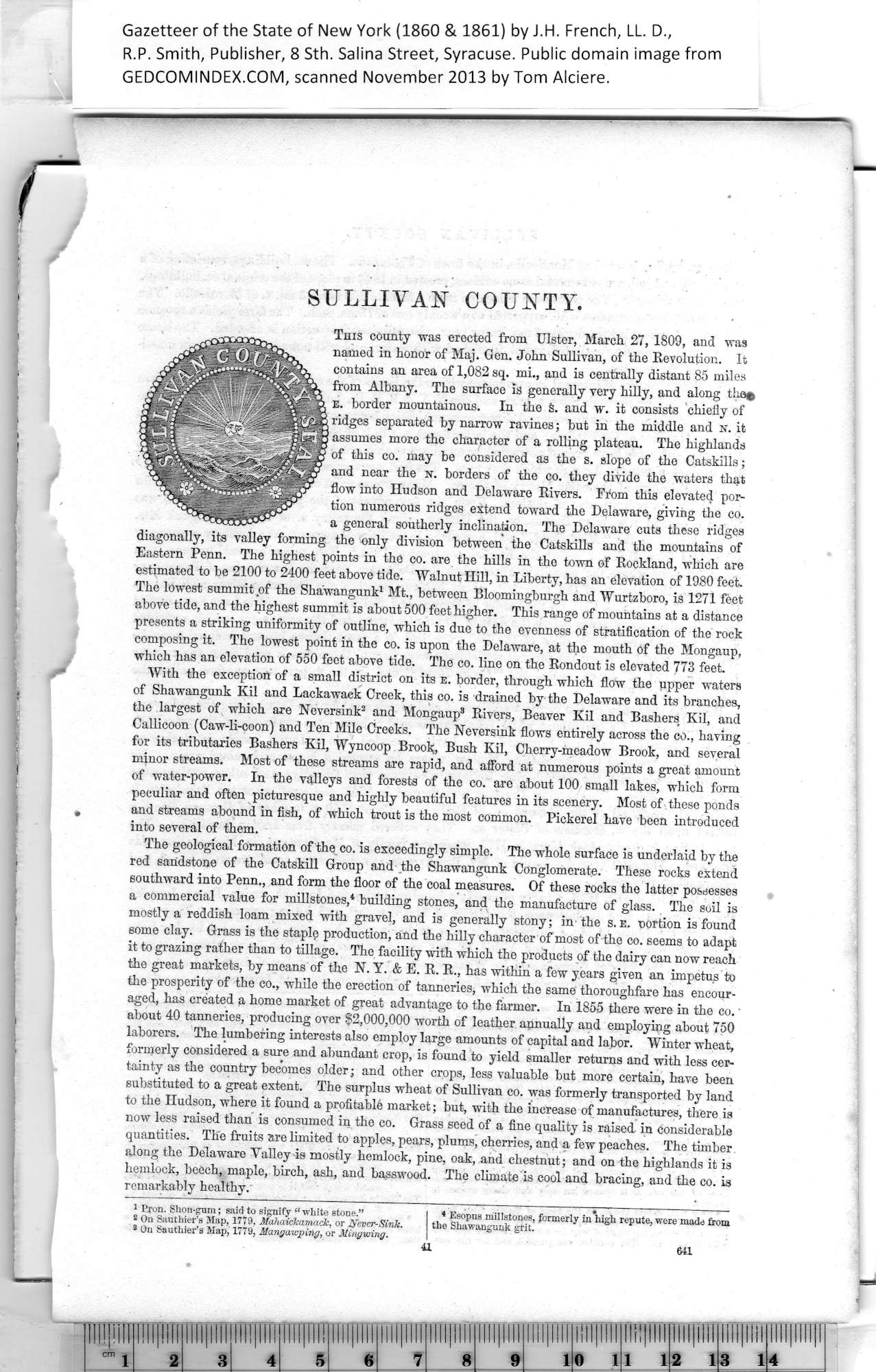|
SULLIVAN COUNTY.
This county was erected from Ulster, March 27, 1809, and was
named in honor of Maj. Gen. John Sullivan, of the Revolution. It
contains an area of 1,082 sq. mi., and is centrally distant 85 miles
from Albany. The surface is generally very hilly, and along tiie^
E. border mountainous. In the S. and w. it consists chiefly of
ridges separated by narrow ravines; but in the middle and n. it
assumes more the character of a rolling plateau. The highlands
of this co. may be considered as the s. slope of the Catskills;
and near the n. borders of the co. they divide the waters that
flow into Hudson and Delaware Rivers. From this elevated por¬
tion numerous ridges extend toward the Delaware, giving the co.
a general southerly inclination. The Delaware cuts these ridges
diagonally, its valley forming the only division between the Catskills and the mountains of
Eastern Penn. The highest points in the co. are the hills in the town of Rockland, which are
estimated to be 2100 to 2400 feet above tide. Walnut Hill, in Liberty, has an elevation of 1980 feet.
The lowest summit^of the Shawangunk1 Mt., between Bloomingburgh and Wurtzboro, is 1271 feet
above tide, and the highest summit is about 500 feet higher. This range of mountains at a distance
presents a striking uniformity of outline, which is due to the evenness of stratification of the rock
composing it. The lowest point in the co. is upon the Delaware, at the mouth of the Mongaup,
which has an elevation of 550 feet above tide. The co. line on the Rondout is elevated 773 feet.
With the exception of a small district on its e. border, through which flow the upper waters
of Shawangunk Kil and Lackawack Creek, this co. is drained by the Delaware and its branches,
the largest of which are Neversink1 and Mongaup2 Rivers, Beaver Kil and Bashers Kil, and
Callicoon (Caw-li-coon) and Ten Mile Creeks. The Neversink flows entirely across the co., having
for its tributaries Bashers Kil, Wyncoop Brook, Bush Kil, Cherry-meadow Brook, and several
minor streams. Most of these streams are rapid, and afford at numerous points a great amount
of water-power. In the valleys and forests of the co. are about 100 small lakes, which form
peculiar and often picturesque and highly beautiful features in its scenery. Most of these ponds
and streams abound in fish, of which trout is the most common. Pickerel have been introduced
into several of them.
The geological formation of the co. is exceedingly simple. The whole surface is underlaid by the
red sandstone of the Catskiil Group and the Shawangunk Conglomerate. These rocks extend
southward into Penn., and form the floor of the coal measures. Of these rocks the latter possesses
a commercial value for millstones,3 building stones, and the manufacture of glass. The soil is
mostly a reddish loam mixed with gravel, and is generally stony; in the s.e. portion is found
some clay. Grass is the staple production, and the hilly character of most of the co. seems to adapt
it to grazing rather than to tillage. The facility with which the products of the dairy can now reach
the great markets, by means of the N. Y. & E. R. R., has within a few years given an impetus to
the prosperity of the co., while the erection of tanneries, which the same thoroughfare has encour¬
aged, has created a home market of great advantage to the farmer. In 1855 there were in the co.'
about 40 tanneries, producing over $2,000,000 worth of leather annually and employing about 750
laborers. The lumbering interests also employ large amounts of capital and labor. Winter wheat,
formerly considered a sure and abundant crop, is found to yield smaller returns and with less cer¬
tainty as the country becomes older; and other crops, less valuable but more certain, have been
substituted to a great extent. The surplus wheat of Sullivan co. was formerly transported by land
to the Hudson, where it found a profitable market; but, with the increase of manufactures, there,is
now less raised than is consumed in the co. Grass seed of a fine quality is raised in considerable
quantities. The fruits are limited to apples, pears, plums, cherries, and a few peaches. The timber
along the Delaware Yalley is mostly hemlock, pine, oak, and chestnut ; and on the highlands it is
hemlock, beech, maple, birch, ash, and basswood. The climate is cool and bracing, and the co. is
remarkably healthy. .
1
1 Pron. Shon-gum; said to signify “ white stone.” I * Esopus millstones, formerly in high repute, were made from
2
On Sautbier’s Map, 1779, Mahaickamack, or jyever-Sink. the Shawangunk grit.
3
8 On Sauthier’s Map, 1779, Mangawping, or Mingwing.
|
